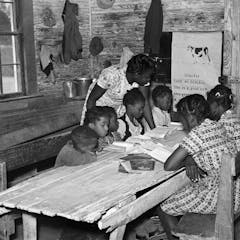
Articles on Brown v. Board of Education
Displaying 1 - 20 of 41 articles

The next time you hear about a Supreme Court concurrence or dissent, pay attention. You may get a window to where the law is headed in the future.

As the nation marks the 70th anniversary of Brown v. Board, one of its most significant side effects − the large-scale loss of Black teachers − continues to affect America’s schools.

With their upcoming decision concerning whether Donald Trump can appear on the Colorado ballot, Supreme Court justices face the possibility that the ruling could be ignored or defied by the public.

A court long known for its landmark decisions expanding civil rights is now known for highly conservative rulings reining in government power.

As the nation approaches the 70-year anniversary of Brown vs. Board of Education, an education professor lays out the state of school segregation in America.

During the civil rights era, Black teachers were valued members of the community and often taught generations of family members.

Throughout Thomas’ tenure on the court, he has pushed the Supreme Court to replace Marshall’s vision with one more amenable to the powerful than the powerless.

What’s at stake when Americans lose faith in the legitimacy of the Supreme Court?

An analysis shows that Black students at more racially segregated schools have a greater tendency to turn to the bottle.

The effort to give every student equal access to an education has lasted decades and may need even more time before the goal is reached.

The Brown v. Board of Education case, which resulted in the Supreme Court outlawing school segregation, originally started in Clarendon County, South Carolina.

Though the 1954 Brown v. Board ruling required the integration of public education, US schools remain separated by race.

Lawmakers in the US Senate are set to vote on a bill that would enshrine abortion into law. But is there a route to legislation?

President Joe Biden has urged lawmakers to act over abortion rights following the Supreme Court decision to overturn Roe v. Wade. But is there a route to legislation?

In the early 1960s, the McDonogh 19 school was the site of fierce opposition to racial integration. The building is now owned by one of the Black girls who first integrated the school.

Local control over school funding leads to uneven resources between districts, two legal scholars maintain.

Brown v. Board didn’t overrule ‘separate-but-equal’ but it had that end. A law scholar explains how there is a lesson there for conservatives on today’s Court looking to end abortion in the US.

Despite a historically diverse high court, its voting rules often fail to include minority viewpoints. That could be avoided if justices decided their cases by unanimous vote.

Americans’ collective memory of school desegregation involves crowds of screaming white protesters. But less well known are the whites who stood by quietly, and those who approved of the changes.

The Supreme Court is a leading player in enacting policy in the US. But it has no army to enforce its decisions; its authority rests solely on its legitimacy.
